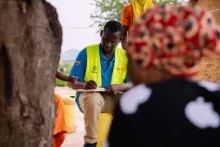
The Building Resilience project in Turkana County, Kenya, established and supported Community Disaster Management Committees (CDMCs) to strengthen local-level disaster risk management, improve community engagement, and integrate community disaster plans into county-level systems.
Map
Community Disaster Management Committees
General Information
ISIG
Community committees for stregthening disaster management
Communities in Turkana face recurring shocks such as drought, floods, disease outbreaks, livestock theft, fire, and conflict. Limited community-level disaster preparedness and weak representation of diverse groups hindered effective risk management.
Needs Addressed
CDMCs were deliberately structured to include representation of women, youth, elderly, and disabled community members, ensuring diverse participation in decision-making.
- Enable communities to assess, plan, and respond to disaster risks
- Build capacity of CDMCs to manage community-specific disaster risk initiatives
- Ensure inclusivity and representation in disaster planning
- Link community plans with county government systems for sustainability
- Formation of CDMCs through community meetings (approx. 60 participants per site)
- Participatory Disaster Risk Assessment (PDRA) to identify and rank risks
- Selection of 10–15 CDMC members by wider community participants
- Training on contingency planning, long-term development plans, and proposal writing
- Support in opening bank accounts and applying for small-scale community grants
- Trainings on livelihoods, business practices, rights, governance, and advocacy
- Establishment of community feedback mechanisms and anonymous reporting via mobile phone
- Coordination with county government and NGOs to support CDMC proposals
Community members take part in large initial meetings where they identify and rank the main disaster risks facing their community using Participatory Disaster Risk Assessment (PDRA). From these meetings, 10–15 representatives are selected to form the CDMC. CDMC members then play a central role in shaping community-specific interventions. They develop contingency and long-term development plans, propose small-scale projects, and manage grants to implement these initiatives. Their input directly informs which activities are prioritized, how resources are allocated, and how projects are executed. Additionally, CDMCs participate in coordination with county government and NGOs, ensuring that community priorities are integrated into broader planning processes. Feedback mechanisms, such as anonymous mobile phone reporting lines, further enable participants to influence ongoing decision-making and hold implementers accountable.
The CDMC built long-term resilience and decision-making by giving communities structured platforms to assess risks, plan interventions, and manage local projects. Capacity-building in planning, governance, and financial management empowered members to make informed decisions, while integration into county systems ensured sustainability.
Hazard Type
Geographical Scope - Nuts
Population Size
Population Density
Vulnerable Groups
Governance
Emergency Preparedness
Infrastructure Readiness
Engagement Level
Empowerment Level
Implementation
CDMCs were inclusive and participatory, building community ownership and legitimacy. They received capacity-building in planning, proposal writing, and financial management, integrated their plans into county development systems, and facilitated small-scale community initiatives. Early-warning systems and the emergency envelope mechanism supported informed decision-making and rapid response, with evaluations showing higher engagement and awareness among participating households.
Swahili
Oxfam GB, through the La Nina Consortium.
It has extensive experience in community-level disaster risk management and humanitarian response.
- CDMC members and the wider community
- County government officials
- Private sector actors for community initiatives
- Conduct community meetings and PDRA
- Select CDMC members ensuring representation
- Train CDMCs in contingency and development planning
- Support CDMCs in drafting proposals and managing grants
- Integrate CDMC plans into county-level planning
- Provide trainings on livelihoods, business, governance, and advocacy
- Establish community feedback and accountability mechanisms
- Coordinate with county government and NGOs for support and early-warning systems
- Utilize emergency envelope mechanism for rapid response guided by CDMC input
- Human resources: Trained CDMC members, facilitators for participatory risk assessments, trainers for capacity-building in disaster management, governance, advocacy, and financial management.
- Financial resources: Small-scale grants for community-led initiatives, funds to support training, workshops, and operational costs of CDMCs.
- Technical resources: Early-warning systems, monitoring tools for livestock and disaster risks, mobile phone feedback lines for accountability, and support for proposal writing and planning.
July 2012 - April 2015
Experience of the Implementing Organisation in DRM
Target Audience
Resources Required
Timeframe & Phases
Participation Results
- CDMCs successfully increased community engagement in disaster planning
- CDMCs enhanced awareness of contingency plans and built confidence in local disaster response capacity
- Participatory selection and representative composition of CDMCs fostered legitimacy and inclusivity
- Capacity-building enabled CDMCs to manage community initiatives, write proposals, and access small grants
- Integration into county systems provides potential for sustainability and broader impact
Information on challges and adaptive strategies is not available.
Specific information on risk and mitigation plan is not available. However, based on the CDMC model and its implementation context in Turkana, we can infer some general risks and potential solutions.
- Low participation or poor representation: Ensure inclusive, participatory selection of CDMC members.
- Limited CDMC capacity: Provide training in disaster management, planning, governance, and advocacy.
- Weak government integration: Link CDMC plans with county-level disaster-management systems.
- Mismanagement of resources: Apply formal grant procedures and financial accountability measures.
- Poor information flow: Use early-warning systems and feedback channels for communication.
- External shocks (e.g., drought, conflict): Combine community planning with rapid response mechanisms like the emergency envelope.
Risk & Mitigation Plan
Scalability and Sustainability
The sustainability of the CDMCs is supported through the integration of their plans into county-level disaster-management frameworks. The training and capacity-building provided to CDMC members enable them to continue leading community initiatives independently. Financial and operational continuity is further reinforced through access to small-scale grants and formal linkages with the county government.
The CDMC approach is scalable and adaptable, but successful replication requires tailoring representation, risk assessments, training, and financial/logistical support to the local social, economic, and environmental context.
Logistical sustainability, including the direct costs of implementing specific activities, is reinforced through county government integration and capacity-building initiatives that enable CDMCs to effectively carry out disaster management and community engagement functions.
Partial financial sustainability is achieved through small-scale grants managed directly by the CDMCs, which cover operational costs such as administration, monitoring, and day-to-day functioning.